This tool was created in collaboration with researchers from North Carolina State University (NCSU), All India Institute of Medical Sciences (AIIMS), Statconsulta and sponsored by DST.

Why this tool has been developed?
Air pollution (especially PM2.5) impacts health which could be both indoor and outdoor air pollution. Different sources attribute air pollution which could be the transport sector, industry (such as power plants, brick manufacturing, stone crushers), dust (road and soil dust), agriculture (farm waste burning), diesel generator sets, refuse burning, and residential biomass burning. Thus, we wanted to assess and quantify the relationship between major air pollutants and respiratory illnesses. The two key factors influencing this relationship are temperature, humidity. For this, we developed a digital tool that can estimate the variation in the reported respiratory illness in the community with a change in air pollution (PM2.5) levels. An increase in PM2.5 concentrations may result in impacts ranging from discomfort to individuals, workday loss, or school day loss; it leads to an increase in medical costs for individuals and the government. Thus emerges the need to track health effects to prompt strategic action.
This tool uses weather and air pollution parameters as exposure variables which include PM2.5, NOx, humidity, temperature, ozone, and the health outcome is the count of patients visiting Mohalla (neighbourhood) Clinics for respiratory illness in Delhi. This allows the user to choose a linear (direct) relation as this relationship is most easy to understand. However, the effect of pollutants may not increase linearly. Therefore, we have used GAM models to visualize the relationship and displayed this through various graphs.
Who can use it?
The prototype digital tool can be used by academicians, researchers, and policymakers. The policymakers can adopt action to reduce the impact of air pollution on health through this app well in advance. We can upload similar data from other locations and assess similar relationships.

How will it benefit any stakeholder?
This app can help in similar time-series analyses especially in the most vulnerable groups i.e. children, pregnant women, and senior residents. It also assesses the impact of air population with pre-existing medical conditions such as respiratory illnesses, diabetes, heart diseases. This assessment can inform preparedness and action plans for health care system administration, school system administration, and individuals.
This tool was created in collaboration with researchers from North Carolina State University (NCSU), All India Institute of Medical Sciences (AIIMS), Statconsulta and sponsored by DST.
